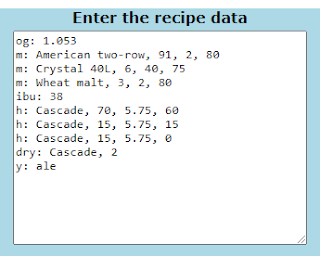The Beer Engine 2024 software was created to power the FlexStyle calculators that create a recipe based on beer styles. Later, it occurred to me that sometimes brewers just want to share a recipe with others without exploring the intricacies of a beer style. Something more compact than FlexStyle would be very practical for sharing purposes.
Communicating brewing recipes is awkward because brewers have differences in equipment and processes. Mash efficiency is a key issue. Commercial breweries that continuous (fly) sparge might have 90% efficiency whereas a brew-in-a-bag homebrewer might get 70% efficiency. Simply reporting the weights in a grain bill can is problematic because of these differences. The 70% brewer will need more grain for the same volume than the 90% brewer. There needs to be a way to easily bridge this gap.
The Beer Engine 2024 - Concise software has the critical recipe variables in a single field. Simple codes are used like m: for malt and h: for hops. The values associated with a variable are separated by commas (i.e., comma separated values) and can be easily edited by the user if desired. Here are two examples.
m: Malt name, fermentable percentage, Lovibond, and yield (SG or percent)
h: Hop name, IBU %, alpha acid %, and boil minutes
Here's an example for a basic American pale ale.
In brief, the grain bill is 91% American two-row malt, 6% crystal 40L, and 3% wheat malt. The hops are all Cascade at 5.75% alpha acids, with additions at 60, 15, and 0 minutes.
The og: line is original gravity, which can be either specific gravity or degrees Plato. The ibu: variable is the target bitterness. The dry: is for dry hops (grams/liter). Finally, y: is for yeast type to calculate the pitching rate. The rest of the inputs are user-specific variables, such as the desired volume and mash efficiency. Altogether, this method provides a very compact method for specifying the recipe parameters.
The field can be edited. For example, if a brewer's hops are 5% alpha acids instead of 5.75%, the values can be changed to fit the brewer's hops. A second example is that the type of hops could be switched, like Cascade to Centennial, by changing the hop name and the associated alpha acids.
This recipe format is very portable. To illustrate, a print magazine could publish the code shown above on paper. The brewer could type it into the Beer Engine 2024 - concise page and press the button to get the weights needed for their specific brewing situation. No software purchase would be needed because this is available for free on the web and has open-source licensing.
Here are a few concise recipe calculators to explore.

